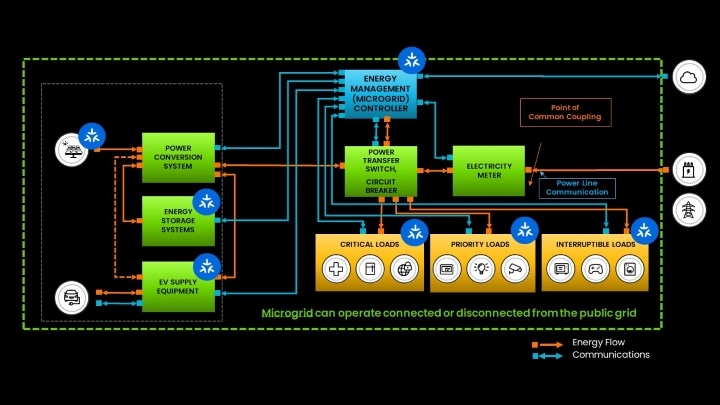正如上周的“Wireless Wednesday”博文中所承诺的那样,本周我们将深入探讨Matter 1.4的所有内容。
CSA于11月7日发布Matter 1.4,在几个重要领域提供支持,包括新增的能源管理设备类型和功能、家庭网络基础设施和增强型多管理员功能。恩智浦与各行业公司合作,帮助他们构建和推出与Matter兼容的产品组合,在开发和部署阶段为其提供支持,并将他们的应用需求和用例纳入Matter标准的制定中。
恩智浦对Matter 1.4引入或增强的各个关键领域充满了期待,并与众多合作伙伴和客户携手合作,致力于推动这些功能的实现和部署,以进一步巩固Matter在自动化家居中的基础。随着Matter的不断发展,恩智浦认为,Matter 1.4所支持的功能和设备类型的演进,以及Matter 1.5中计划的改进和扩展,将大大促进Matter的普及,为最终用户带来巨大的价值和多方面的好处。恩智浦特别关注的三个关键领域包括:
能源管理
恩智浦认为,没有智能能源和协调,就无法实现从智能家居向真正自动化家居的演进。有了Matter 1.4,实现能源设备和关键负载协同工作的许多基本要素现已到位。这些用于设备级能源管理控制和报告的要素,为设备在本地(设备到设备)运行提供了基础,而无需依赖于云端及其带来的复杂性。恩智浦将继续与合作伙伴紧密合作,在未来的Matter版本中扩展这一基础,增加更多的能源设备类型增强功能,以及与公共电网和其它相关能源来源协作的能力。
 恩智浦对家庭和其它微电网能源管理的看法
恩智浦对家庭和其它微电网能源管理的看法
家庭网络基础设施
为了让消费者能够直接创建基于Matter的智能家居环境,满足他们的偏好和需求,他们的家中必须拥有合适的基础设施。Matter 1.4增加了对家庭路由器和接入点(HRAP)的认证支持,这些认证功能可以整合到新的HRAP设备中,或升级到目前家中已安装的HRAP设备中。这将为Matter所需的无缝连接创建更多路径。
增强型多管理员功能
Matter为消费者提供了构建智能家居的多项选择和灵活性,使他们能够根据功能和体验来做出购买决策,而不是受限于某个特定的生态系统或品牌。自Matter 1.4起,增强型多管理员功能已被引入,并计划在Matter 1.5中进一步扩展和改进,使最终用户的体验更加简单和强大。
Matter 1.4的新功能:
能源管理设备类型和功能
Parks Associates*的最新研究表明,家庭能源管理正成为推动消费者采用智能家居设备的主要原因之一。消费者不仅想知道家中每台设备和电器的能源消耗情况,还希望通过例程和自动化来帮助他们节省能源,减少能源账单,而无需手动调整。随着Matter 1.4中引入了新设备类型和功能,可以满足消费者的上述需求。在Matter 1.3更新中,我们引入了能源报告,实现了大型电器和电动汽车供电设备的能源管理用例。Matter 1.4通过增加对太阳能电池板、电池、热泵和热水器等新设备的支持,进一步扩展了其能源管理能力。这些新增功能,以及对能源管理和恒温器集群的改进,为家中更智能、更自动化的能源管理铺平了道路。
- 新设备类型:太阳能、电池、热泵、热水器
- 增强型设备类型:EVSE、恒温器
- 特性:设备能源管理和模式
(信息来源:连接标准联盟公告)
配备家庭路由器和接入点(HRAP)的网络基础设施
对于家庭路由器、调制解调器、接入点和机顶盒等设备,现在可以设计新型号或升级现有型号,为基于Matter的智能家居提供更强大的支持。通过结合Wi-Fi接入点和Thread边界路由器,Matter认证的HRAP设备为智能家居提供了基本的基础架构,确保这些无处不在的设备具有使用这两种技术的Matter产品所需的基础设施。HRAP设备还包含用于存储和共享Thread网络凭证的安全目录。这种标准化的方法使用户能够更轻松地添加新的Thread边界路由器,并在现有的Thread网络中添加设备,而无需创建新的Thread网络,从而实现统一的Thread网状网络的优势并减少网络碎片。在此基础上,HRAP路线图将继续增加增强功能,以改善智能家居基础设施,并支持Thread 1.4中的增强功能。
增强型多管理员功能
多管理员是Matter选择和互操作性愿景的核心,允许用户将Matter设备连接到多个智能家居系统。然而,随着用户不断扩展他们的智能家居,在家中的多个生态系统之间分别共享每台设备可能会变得繁琐且复杂。增强型多管理员功能使智能家居管理更加轻松,只需用户一次性同意,即可使现有设备和新设备自动连接甚至加入多个生态系统。
Matter 1.4和未来的版本为开发人员提供了灵活的方法,可以根据他们的应用程序实现这种可选体验。
针对电池供电设备的优化
Matter 1.4引入了核心增强功能,旨在优化开关、按钮和传感器等间歇性连接设备(ICD)的电池寿命和通信。关键更新包括延长电池寿命的长空闲时间(LIT)协议,以及新的签入协议,以确保需要长空闲时间的低功耗设备能够可靠地通信。此外,更安静地报告可预测的属性变化可以减少网络流量,从而提高电池性能和网络效率。
占用感测
在现有的传感器集群上增强了功能,支持雷达、视觉和环境传感技术等传感功能。还引入了可定制的灵敏度设置,并通过基于事件的更新,提升了传感器和历史报告的调校,提供了更精确和适应性更强的智能家居体验。这些改进为未来支持新一代传感技术奠定了基础,实现人员检测和活动分类等功能。
安装开/关和可调光负载控制
扩展对为有线设备供电的固定式墙内智能家居设备的支持,例如用于控制照明、风扇和其它非智能电器的墙内开关。过去建模中一般使用照明,这可能会限制用户界面或自动化的灵活性。
恩智浦对Matter的投资
恩智浦提供广泛的智能计算、连接和安全产品组合,并持续投资,帮助客户将Matter技术融入他们的产品组合中,并集成互补技术,创造更高层次和差异化的体验。Matter 1.4扩展了Matter在智能家居关键领域的功能,如能源管理和环境感知,以及基础设施支持和生态系统管理的增强,恩智浦不断推动Matter关键功能的开发和赋能,并积极参与开发平台的认证,便于开发平台以强大、高效的方式采用和部署最新功能。这些设备类型和功能正在完成恩智浦Matter开发平台上的官方认证。这些平台将恩智浦领先的智能计算平台与三频无线和多协议连接相结合,并集成恩智浦EdgeLock IP基于硬件的安全性和服务。
恩智浦在能源智能与控制领域的投资
设备级的能源管理和报告是优化家庭、楼宇和其它微电网的能效和可持续性的关键技术。这些微电网集成了各种分布式能源(DER),如太阳能电池板、风力发电机、传统发电机和储能系统(ESS)。能源管理还需进一步与公共电网协调,以均衡负载,并优先考虑本地能源分配。
恩智浦的先进技术促进开发有助于能源管理的智能系统:
- 自主监测和优化运营成本
- 可靠地平衡进出宏电网的实时电力流
- 可靠、安全地连接场内外的设备
恩智浦的能源解决方案可支持全世界所需的更清洁、更高效的能源基础设施。更多信息,请访问nxp.com/energy。


